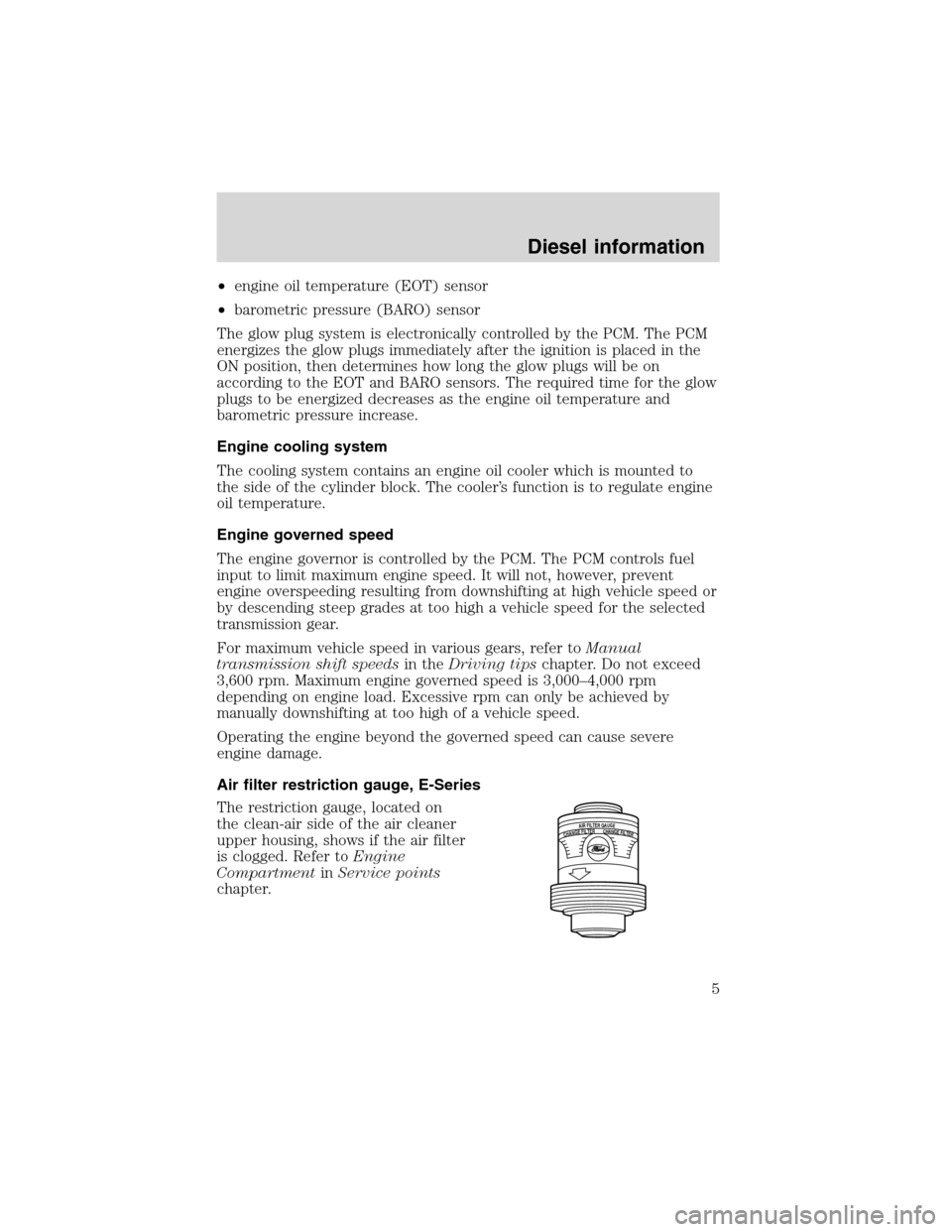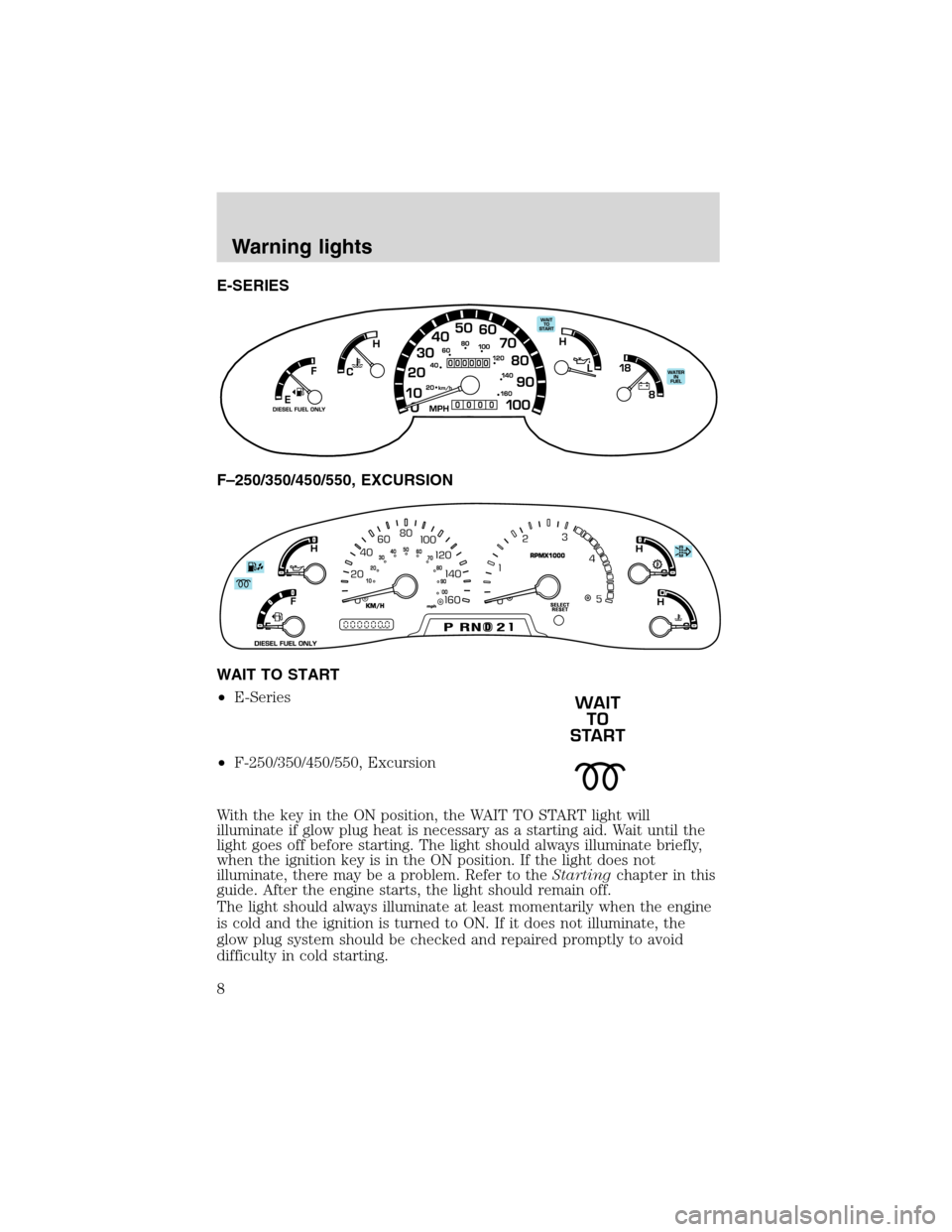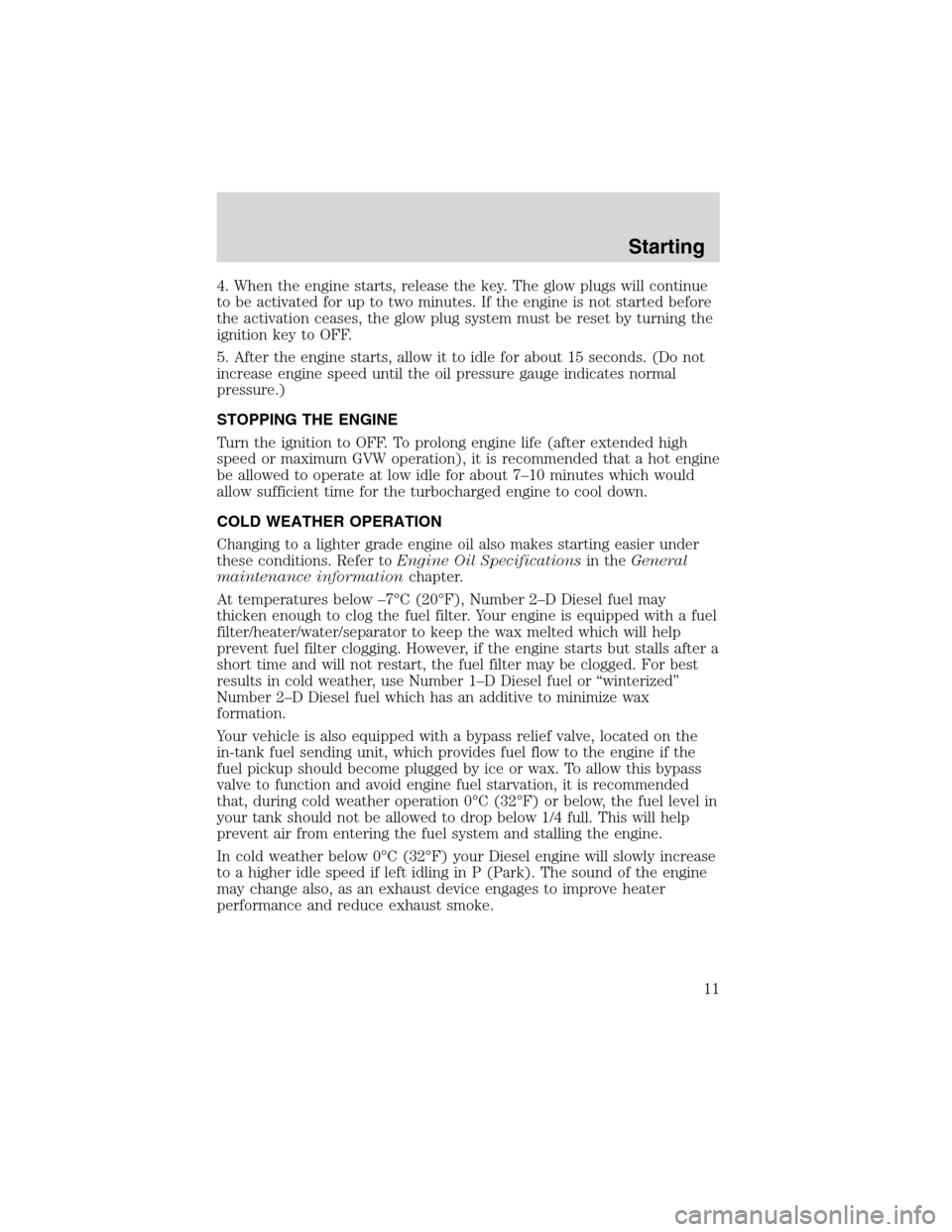2003 FORD SUPER DUTY ignition
[x] Cancel search: ignitionPage 5 of 56

•engine oil temperature (EOT) sensor
•barometric pressure (BARO) sensor
The glow plug system is electronically controlled by the PCM. The PCM
energizes the glow plugs immediately after the ignition is placed in the
ON position, then determines how long the glow plugs will be on
according to the EOT and BARO sensors. The required time for the glow
plugs to be energized decreases as the engine oil temperature and
barometric pressure increase.
Engine cooling system
The cooling system contains an engine oil cooler which is mounted to
the side of the cylinder block. The cooler’s function is to regulate engine
oil temperature.
Engine governed speed
The engine governor is controlled by the PCM. The PCM controls fuel
input to limit maximum engine speed. It will not, however, prevent
engine overspeeding resulting from downshifting at high vehicle speed or
by descending steep grades at too high a vehicle speed for the selected
transmission gear.
For maximum vehicle speed in various gears, refer toManual
transmission shift speedsin theDriving tipschapter. Do not exceed
3,600 rpm. Maximum engine governed speed is 3,000–4,000 rpm
depending on engine load. Excessive rpm can only be achieved by
manually downshifting at too high of a vehicle speed.
Operating the engine beyond the governed speed can cause severe
engine damage.
Air filter restriction gauge, E-Series
The restriction gauge, located on
the clean-air side of the air cleaner
upper housing, shows if the air filter
is clogged. Refer toEngine
CompartmentinService points
chapter.
AIRFILTERGAUGECHANGEFILTERCHANGEFILTER
Diesel information
5
Page 8 of 56

E-SERIES
F–250/350/450/550, EXCURSION
WAIT TO START
•E-Series
•F-250/350/450/550, Excursion
With the key in the ON position, the WAIT TO START light will
illuminate if glow plug heat is necessary as a starting aid. Wait until the
light goes off before starting. The light should always illuminate briefly,
when the ignition key is in the ON position. If the light does not
illuminate, there may be a problem. Refer to theStartingchapter in this
guide. After the engine starts, the light should remain off.
The light should always illuminate at least momentarily when the engine
is cold and the ignition is turned to ON. If it does not illuminate, the
glow plug system should be checked and repaired promptly to avoid
difficulty in cold starting.
Warning lights
8
Page 9 of 56

WATER IN FUEL
•E-Series
•F-250/350/450/550, Excursion
During refueling, it is possible for water-contaminated diesel fuel to be
pumped into your tank. Your vehicle fuel system is equipped with a fuel
filter/water separator to remove water from the fuel. The WATER IN
FUEL light will illuminate when the ignition is turned to START (as part
of the light function check) and when the fuel filter/water separator has
a significant quantity of water in it.
If the light illuminates when the engine is running, stop the vehicle as
soon as safely possible, shut off the engine, then drain the filter bowl.
Refer to theGeneral maintenancechapter for drain procedure.
Allowing water to stay in the system could result in extensive damage to,
or failure of, the fuel injection system.
Do not drain the water separator while the engine is running.
Fuel may ignite if the separator is drained while the engine is
running or the vehicle is moving.
ENGINE AIR FILTER (F-250/350/450/550 & EXCURSION)
The engine air filter warning light
illuminates when the air filter
restriction gauge reaches the
CHANGE FILTER mark.
The vehicle may be driven with the engine air filter warning light
illuminated for up to 400 km (250 miles) without damaging the engine or
related components. However, the air filter elementmustbe replaced at
the earliest opportunity. Refer toAir filter restriction gaugein the
Diesel informationchapter for more information.
Warning lights
9
Page 11 of 56

4. When the engine starts, release the key. The glow plugs will continue
to be activated for up to two minutes. If the engine is not started before
the activation ceases, the glow plug system must be reset by turning the
ignition key to OFF.
5. After the engine starts, allow it to idle for about 15 seconds. (Do not
increase engine speed until the oil pressure gauge indicates normal
pressure.)
STOPPING THE ENGINE
Turn the ignition to OFF. To prolong engine life (after extended high
speed or maximum GVW operation), it is recommended that a hot engine
be allowed to operate at low idle for about 7–10 minutes which would
allow sufficient time for the turbocharged engine to cool down.
COLD WEATHER OPERATION
Changing to a lighter grade engine oil also makes starting easier under
these conditions. Refer toEngine Oil Specificationsin theGeneral
maintenance informationchapter.
At temperatures below–7°C (20°F), Number 2–D Diesel fuel may
thicken enough to clog the fuel filter. Your engine is equipped with a fuel
filter/heater/water/separator to keep the wax melted which will help
prevent fuel filter clogging. However, if the engine starts but stalls after a
short time and will not restart, the fuel filter may be clogged. For best
results in cold weather, use Number 1–D Diesel fuel or“winterized”
Number 2–D Diesel fuel which has an additive to minimize wax
formation.
Your vehicle is also equipped with a bypass relief valve, located on the
in-tank fuel sending unit, which provides fuel flow to the engine if the
fuel pickup should become plugged by ice or wax. To allow this bypass
valve to function and avoid engine fuel starvation, it is recommended
that, during cold weather operation 0°C (32°F) or below, the fuel level in
your tank should not be allowed to drop below 1/4 full. This will help
prevent air from entering the fuel system and stalling the engine.
In cold weather below 0°C (32°F) your Diesel engine will slowly increase
to a higher idle speed if left idling in P (Park). The sound of the engine
may change also, as an exhaust device engages to improve heater
performance and reduce exhaust smoke.
Starting
11
Page 46 of 56

IF THE ENGINE WON’T CRANK
Turn on the headlights. If the lights are dim, do not go on at all or if
when the ignition is turned to START the lights become dim or go out,
the battery connections may be loose or corroded, or the battery may be
discharged. If there is a clicking or stuttering sound coming from the
engine compartment when you turn the key to START, this may also
indicate a loose or corroded battery connection.
Check the battery connections at the battery posts, cable connection to
the engine grounding point and at the starter relay terminals. Also, make
sure the relay bracket is securely fastened to its mounting surface.
If the starter relay clicks, but the starter does not crank, check the
connections at the starter terminal. If a discharged battery is suspected,
have it checked and corrected.
•For vehicles with manual transmissions, the clutch pedalmustbe fully
depressed in order for the starter to operate.
•For vehicles with automatic transmissions, the gearshift lever must be
in Park or Neutral in order for the starter to operate.
•Try operating the starter switch several times. Should the switch be
corroded, this operation may clean the contacts or make the switch
temporarily operable until you can reach the dealer.
•If all electrical connections are tight and you need assistance to start,
see“Jump Starting Your Vehicle”.
IF ENGINE CRANKS BUT WON’T START
Prolonged starter cranking (in excess of 30 seconds) could cause
damage to the starter motor.
•Check the fuel gauge. You may be out of fuel. If the gauge shows that
there is fuel in the tank, the trouble may be in the electrical system or
the fuel system. If equipped with an auxiliary tank, be sure that the
tank control switch is set for the tank with fuel and not on an empty
tank.
•Leaving the ignition key ON for over two minutes without starting may
make starting difficult because the glow plugs will cease activation.
Reset the system by turning the ignition key to OFF and then back to
ON again.
Minor troubleshooting guide
46